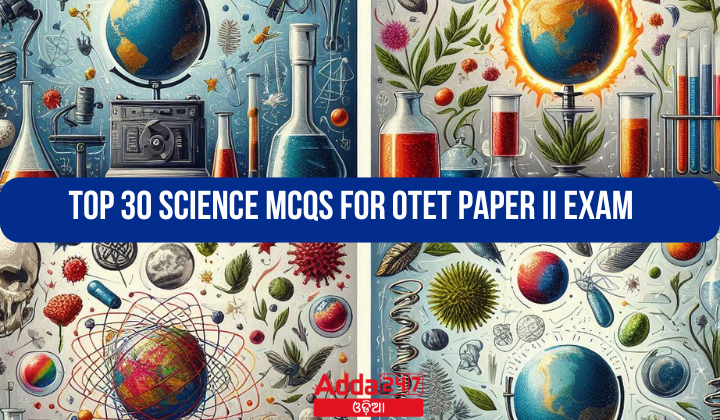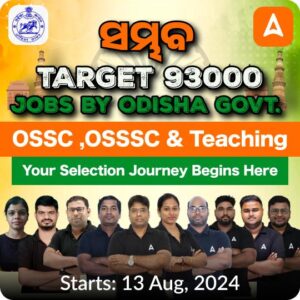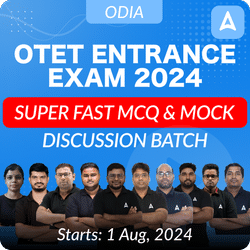Preparing for the OTET Paper II Exam requires a solid understanding of science concepts. This compilation of the top 30 science MCQs is tailored to help candidates gauge their knowledge and improve their chances of success. These questions cover a wide range of topics from physical science to life science, including key areas such as metals, non-metals, metalloids, chemical reactions, force, motion, and the solar system. Practicing these questions will not only test your understanding but also familiarize you with the exam format and the type of questions asked.
Top 30 Science MCQs For OTET Paper II Exam 14 August 2024
- What is the primary aim of teaching science at the upper primary stage?
(a) Memorization of scientific facts
(b) Development of scientific temper
(c) Preparation for competitive exams
(d) Learning complex theories
Ans. (b) Development of scientific temper - Which of the following is NOT an objective of teaching science at the upper primary stage?
(a) Encouraging curiosity about natural phenomena
(b) Promoting rote learning of scientific definitions
(c) Fostering inquiry-based learning
(d) Developing critical thinking skills
Ans. (b) Promoting rote learning of scientific definitions - The nature of science education at the upper primary stage emphasizes which of the following?
(a) Exploration and experimentation
(b) Strict adherence to textbooks
(c) Learning by listening to lectures
(d) Memorizing formulas and equations
Ans. (a) Exploration and experimentation - Which method of teaching science is most suitable for developing observational skills in students?
(a) Lecture method
(b) Observation method
(c) Project method
(d) Problem-solving method
Ans. (b) Observation method - The experimentation method in science teaching primarily aims to:
(a) Provide hands-on experience
(b) Reduce the need for theoretical knowledge
(c) Promote passive learning
(d) Increase textbook dependence
Ans. (a) Provide hands-on experience - Which teaching method encourages students to discover scientific principles on their own?
(a) Discovery method
(b) Lecture method
(c) Dictation method
(d) Drill method
Ans. (a) Discovery method - The project method in science education is best described as:
(a) Teacher-centered
(b) Student-centered
(c) Textbook-centered
(d) Examination-centered
Ans. (b) Student-centered - Problem-solving as a method in science education involves:
(a) Encouraging students to find solutions to real-life problems
(b) Giving students the answers to problems
(c) Memorizing problem statements
(d) Ignoring problem contexts
Ans. (a) Encouraging students to find solutions to real-life problems - Which approach integrates various subjects around a common theme in science teaching?
(a) Integrated approach
(b) Isolated approach
(c) Lecture approach
(d) Rote learning approach
Ans. (a) Integrated approach - The constructivist approach in science teaching emphasizes:
(a) Student’s active involvement in constructing their own understanding
(b) Teacher-centered delivery of content
(c) Memorization of facts
(d) Passive learning through textbooks
Ans. (a) Student’s active involvement in constructing their own understanding - Which of the following is a characteristic property of metals?
(a) Brittle
(b) Dull appearance
(c) Malleable
(d) Poor conductor of electricity
Ans. (c) Malleable - Which metal is liquid at room temperature?
(a) Iron
(b) Copper
(c) Mercury
(d) Aluminum
Ans. (c) Mercury - Non-metals are generally poor conductors of heat and electricity because they:
(a) Have low density
(b) Have free electrons
(c) Have tightly bound electrons
(d) Are ductile
Ans. (c) Have tightly bound electrons - Which of the following is a metalloid?
(a) Carbon
(b) Boron
(c) Sodium
(d) Sulfur
Ans. (b) Boron - What happens to metals when they lose electrons?
(a) They become negatively charged
(b) They remain neutral
(c) They become positively charged
(d) They break into smaller atoms
Ans. (c) They become positively charged - Which of the following non-metals is a good conductor of electricity?
(a) Sulfur
(b) Phosphorus
(c) Graphite
(d) Chlorine
Ans. (c) Graphite - Which of the following elements is commonly used as a semiconductor?
(a) Aluminum
(b) Silicon
(c) Iron
(d) Gold
Ans. (b) Silicon - Which property is not typically associated with non-metals?
(a) High melting point
(b) Brittle
(c) Poor conductor of heat
(d) Low density
Ans. (a) High melting point - Which animal uses skin as a respiratory organ?
(a) Cockroach
(b) Frog
(c) Whale
(d) Dog Fish
Ans: (b) Frog - Which kingdom represents bacteria?
(a) Monera
(b) Protista
(c) Protozoa
(d) Metazoa
Ans: (a) Monera - The recoiling of a gun is an example of which law?
(a) Law of Conservation of Angular Momentum
(b) Law of Conservation of Linear Momentum
(c) Conversion of Kinetic Energy to Potential Energy
(d) Law of Conservation of Energy
Ans: (b) Law of Conservation of Linear Momentum - What are the components of blood?
(a) Red blood cells and platelets
(b) White blood cells and plasma
(c) Red blood cells, white blood cells, and platelets
(d) Plasma and antigens
Ans: (c) Red blood cells, white blood cells, and platelets - Which of the following is NOT a function of antibodies?
(a) Recognizing foreign substances
(b) Alerting the immune system
(c) Destroying red blood cells
(d) Part of body’s natural defenses
Ans: (c) Destroying red blood cells - How is blood group identified?
(a) By the color of blood cells
(b) By the size of platelets
(c) By the presence of antigens and antibodies
(d) By the number of white blood cells
Ans: (c) By the presence of antigens and antibodies - Which blood group has A antigens on the red blood cells?
(a) Blood group A
(b) Blood group B
(c) Blood group O
(d) Blood group AB
Ans: (a) Blood group A - Which blood group has B antigens on the red blood cells?
(a) Blood group A
(b) Blood group B
(c) Blood group O
(d) Blood group AB
Ans: (b) Blood group B - What is the scientific name for the Arabian camel?
(a) Camelus dromedarius
(b) Camelus bactrianus
(c) Camelus camelus
(d) Camelus ferus
Ans: (a) Camelus dromedarius - Which family does the African elephant belong to?
(a) Loxodontidae
(b) Elephidae
(c) Elephantidae
(d) Loxodonta
Ans: (d) Loxodonta - To which taxonomic group does the albatross belong?
(a) Procellariiformes
(b) Diomedeidae
(c) Spheniscidae
(d) Laridae
Ans: (b) Diomedeidae - What is the species name for the alpaca?
(a) Vicugna pacos
(b) Lama glama
(c) Vicugna vicugna
(d) Lama pacos
Ans: (a) Vicugna pacos - Which species is commonly referred to as the Asian Elephant?
(a) Elephas maximus
(b) Loxodonta africana
(c) Elephas africanus
(d) Loxodonta cyclotis
Ans: (a) Elephas maximus










